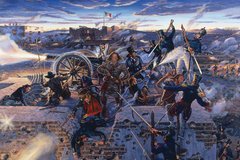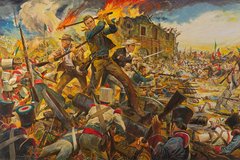[1] John H. Jenkins, ed., “Antonio López de Santa Anna to José María Tornel, March 6, 1836,” Papers of the Texas Revolution (10 vols.; Austin: Presidial Press, 1973), 5:11–512.
[2] Todd Hansen, ed., “Robert McAlpin Williamson, letter, March 1, 1836,” The Alamo Reader (Mechanicsburg, PA: Stakepole Books, 2003), 601; Jenkins, ed., PTR 4:485. The PTR version of Santa Anna’s report omits the mention of captured letters and documents, but a transcription of a letter March 1, 1836, from Williamson to Travis appeared in El Nacional, Suplemento al Numero 79. Jenkins mentioned the letter’s existence but did not provide a copy of it.
[3] Jenkins, ed., “Antonio López de Santa Anna to José María Tornel, March 6, 1836,” PTR, 5:512.
[4] Jenkins, ed., PTR: “Barsena et al Deposition, Gonzales, March 11, 1836,” 5:45–46; E. N. Gray to Unknow Recipient, Gonzales, March 11, 1836,” 5;48–49; “Sam Houston to Convention, March 11, 1836,” [report not included], 5:51; Sam Houston to James W. Fannin, Gonzales, March 11, 1836,” 52–53; Sam Houston to James W. Fannin, Gonzales, March 11, 1836,” 5:53–54. Houston’s letter to the Convention appears not to exist. Jenkin’s cited as his source William F. Gray’s mention of several letters from Houston that arrived at Washington on March 15, 1836, which apparently referred to the receipt of copies of Houston’s letters to Fannin and Collinsworth.
[5] Jenkins, ed., PTR, “Sam Houston to Phillip Dimmit, Head Quarters (Gonzales), March 12, 1836,” 5:57–58.
[6] Jenkins, ed., PTR, “Sam Houston to James Collinsworth, Headquarters, Gonzales, March 13, 1836,” 5:69–71; “Sam Houston to Henry Raguet, Gonzales, March 13, 1836, 5:72.
[7] Jenkins, ed., PTR, “Sam Houston to James Collinsworth, Camp at Navadad, March 15, 1836,” 5:82:84; “Santa Anna to Citizens [of Texas],” 5:20–21. It is usually stated that Susanna Dickinson carried a proclamation from Santa Anna promising to protect those loyal to his government and punishment for those who opposed it. However, Houston informed Collinsworth that Santa Anna had “sent [the address] by a negro to the citizens.”
[8] William F. Gray, From Virginia to Texas: Dairy of Col. Wm. F. Gray, (Houston: Gray, Dillaye & Co., Printers, 1909; Houston: Fletcher Young Publishing Cp., 1965), 131. “Mr. Ainsworth” was apparently A. C. Ainsworth, who served as purchasing agent for the Republic of Texas in New Orleans.
[9] Jenkins, ed., PTR, “B. B. Goodrich to Edmond Goodrich, March 16, 1836,” PTR, 5:81–82; “Charles B. Stewart to Ira R. Lewis, March 16, 1836,” 5:93. Stewart, a delegate at the Convention, wrote Lewis at Natchez, Louisiana the news that “The Alamo has fallen, and every unfortunate creature murdered and burnt, some even before they were dead.”
[10] Jenkins, ed., PTR, “Houston Army Orders,” Camp on La Baca, March 14, 1836, 5:77–78; “Gay et al to Public,” San Felipe, March 16, 1836, 5:90. Jenkin’s only mentions Gay’s address but the full text can be found in Streeter, Texas Broadside, #134.
[11] Gray, Diary of Col. Wm. F. Gray, 134. Gray recorded the effect of the news of the Alamo’s fall and the Mexican advance had on the delegates gathered at Washington, writing on March 17, 1836, that “The members are now disappearing in all directions. A general panic seems to have seized them.”
[12] Gray, Diary of Col. Wm. F. Gray, 136–141.
[13] “More Particulars of the Fall of the Alamo,” Telegraph & Texas Register. Thursday, March 24, 1836.
[14] Reprinted in the San Antonio Express, March 6, 1936, “Melancholy News from Texas,” New York Sun, Saturday, April 12, 1836; “Important News from Texas,” The New Yorker, April 16 and 30, 1836; Jenkin’s ed., “[Andrew] Briscoe to Editor [Louisiana Advertiser], 5:258. Information supplied by Briscoe to the Louisiana Advertiser, published on March 28, 1836, said, “Colonels James Bowie and Crockett were among the slain; the first murdered in his bed in which he had been confined by sickness. The latter [Crockett] fell fighting like a tiger.”
[15] Hansen, ed., “Texas,” Commonwealth, Frankfort, Kentucky, July 27, 1866,” The Alamo Reader, 563–564.
[16] Hansen, ed., “George M. Dolson Letter, July 19, 1836,” The Alamo Reader, 608–610.
[17] For a full discussion the executions at the Alamo, see Richard Bruce Winders, “This is a Cruel Truth, But I Cannot Omit It: The Origins and Effect of Mexico’s No Quarter Policy in the Texas Revolution,” Southwest Historical Quarterly, Vol. 120 №4 (April 2017), 413–439.
[18] Jenkins, ed., PTR, “Santa Anna to the Texans,” Velasco, June 1, 1836, 6:487; “Menucan Hunt to President and Cabinet,” Velasco, June 3, 1836, 6:512 “Santa Anna to Burnet,” Velasco, June 3, 1836, 7:20; “Thomas Rusk to Mirabeau B. Lamar,” La Bahía, June 3, 1836, 7:23–24. A careful reading of both the June 9, 1836 Commonwealth article and Dolson’s July 19, 1836 letter reveals that the author’s motive was to prove that Santa Anna was “a cold-blo0ded murderer, and worthy only of the sympathy of cowards and the scorn of great men.” The execution scene as described contrasted Santa Anna’s brutality with Castrillon chivalry. Dolson’s accounts, which he said were based on the eyewitness report of Colonel Juan Almonte, bolstered the case for Santa Anna’s continued captivity — if not death — for his crimes. The main points conveyed in Dolson’s letters were that Crockett was “brave,” Castrillon was “noble,” and Santa Anna was a “monster.” A second Treaty of Velasco between officials of the Republic of Texas and Santa Anna allowed the defeated general to return to Mexico to secure his government’s acceptance of the first treaty. When word leaked out that Santa Anna was to be set free, anger and dismay grew. The two letters appeared shortly after Santa Anna had been removed from the Invincible docked at Velsaco by Texian volunteers. These men, who opposed Santa Anna’s return, took matters into their own hands and refused to allow the ship to sail, setting off a chain of events that delayed his return to Mexico until January 1837.




